Effect of Commercial Trap Design and Location on Captures of Diocalandra frumenti (Fabricius) (Coleoptera: Dryophthoridae) on Palm Trees
Abstract
Simple Summary
Abstract
1. Introduction
2. Materials and Methods
2.1. Initial Tests
2.1.1. Study Areas
2.1.2. Description of the Tests
2.2. Trials to Improve the Effectiveness of the Trapping System
2.2.1. Study Areas
2.2.2. Trap Design
2.2.3. Trap Location
2.3. Trial Procedure
2.4. Statistical Analysis
3. Results
3.1. Overall Results
3.2. Initial Tests
3.3. Trials to Improve Trapping System Efficiency
3.3.1. Trap Design
Effect of Trap Type
Effect of Trap Design
Effect of Trap Base Colour
3.3.2. Trap Location
Effect of Trap Placement Height on the Palm Tree
Effect of Trap Placement Distance on the Palm Tree
Effect of Trap Location Relative to the Palm Tree
4. Discussion
5. Conclusions
Supplementary Materials
Author Contributions
Funding
Data Availability Statement
Acknowledgments
Conflicts of Interest
References
- Fabricius, J.C. Calandra. Systema Eleutheratorum: Secundum Ordines, Genera, Species: Adiectis Synonymis, Locis, Observationibus, Descriptionibus; Impensis Bibliopolii Academici Novi: Kiel, Germany, 1801; Volume II, pp. 429–438. [Google Scholar]
- Lepesme, P. Les Insectes Des Palmiers; Paul Lechevalier: Paris, France, 1947; p. 904. [Google Scholar]
- EPPO Diocalandra frumenti. Available online: https://gd.eppo.int/taxon/DIOCFR (accessed on 20 February 2024).
- Hill, D.S. Agricultural Insect Pest of the Tropics and Their Control, 2nd. ed.; Cambridge University Press Archive, Ed.; Cambridge University Press: Cambridge, UK, 1983; p. 516. ISBN 9780521246385. [Google Scholar]
- Kalshoven, L.G.E. Pests of Crops in Indonesia; Ichtiar Baru—Van Hoeve: Jakarta, Indonesia, 1981; p. 701. [Google Scholar]
- Salomone, F.; Carnero Hernández, A.; Marrero Ferrer, M.; González Hernández, A. Presencia en la zona paleártica de Diocalandra frumenti Fabricius, (Coleoptera, Curculionidae). Boln. Asoc. Esp. Ent. 2000, 24, 263–264. [Google Scholar]
- Lever, R.J.A.W. Pests of the Coconut Palm; Food and Agriculture Organization of the United Nations: Rome, Italy, 1969; p. 190. ISBN 9251008574. [Google Scholar]
- EPPO Diocalandra Taitense. Available online: https://gd.eppo.int/taxon/DIOCTA (accessed on 23 May 2024).
- Giblin Davis, R.M. Borers of Palms. In Insects on Palms; Howard, F.W., Moore, D., Giblin Davis, R.M.A.R., Eds.; CABI Publising, CAB International, UK & New York, USA, 2001; pp. 267–304, ISBN 0851993265.
- Naidu, G.V.B.; Sampath Kumar, S.N. Diocalandra stigmaticollis Gyll., as a Pest of the Arecanut Crop. Curr. Sci. 1963, 32, 425–426. Available online: https://www.jstor.org/stable/24060481 (accessed on 22 May 2024).
- Chakravarthy, A.K. Status of four spotted coconut weevil Diocalandra frumenti (F.) (Curculionidae: Coleoptera) in Karnataka, South India. Insect Environ. 2003, 9, 187–188. [Google Scholar]
- Skaria, B.P.; Thomas, J.; Mathew, S.; Joy, P.P. Stem weevil, Diocalandra stigmaticollis Gyll. (Curculionidae: Coleoptera) damage on Arecanut palms. Indian J. Arecanut Spices Med. Plants 2002, 4, 95–96. [Google Scholar]
- Salomone Suárez, F.; Caballero Ruano, M.; Gonzalo Bartolomé, O.M.; Hernández Hernández, J.; Carnero Hernández, A.; Pérez Padrón, F.; Rodríguez Rodríguez, R.; Rodríguez Rodríguez, J.M.; Muñóz Carpena, R.; Socorro Monzón, A.R. Identificación y propuestas de control de factores bióticos y abióticos que producen depresión y mortalidad de palmeras naturales o implantadas en Canarias. Rev. Agropecu. Granja 2000, 9–13. [Google Scholar]
- EXOS Diocalandra frumenti (Fabricius, 1801). Available online: https://www.biodiversidadcanarias.es/exos/especie/A06915 (accessed on 19 June 2023).
- Santana López, I. Actualización de la Distribución de Diocalandra frumenti en El Archipiélago. Available online: https://www.youtube.com/watch?v=Df1azYQknHk&list=PLQWQlgK_yxT0svVBW6pgl6LkI2HBhrpIa&index=9 (accessed on 19 June 2023).
- Lake, J. Getting Control of Weevil Borers and Leaf Beetles in Palms; The Nursery Papers, No 2; Nursery Industry Association of Australia: Epping, Australia, 1998; p. 4. [Google Scholar]
- Benito Hernández, P.; Hristova Gueorguieva, H.; Moreno García, M. Estudio del estado sanitario de las palmeras del tramo de autopista GC-1 Aeropuerto-Maspalomas. Rev. Agropecu. Granja 2014, 62–69. [Google Scholar]
- Ramos-Cordero, C.; Servicio de Residuos (Cabildo de Gran Canaria); Laich, F.; Hristova, H.; Hernández Suárez, E. Viabilidad del compostaje de los restos de poda de palmera infestada por Diocalandra frumenti Fabricius, para su aplicación como abono orgánico en jardinería. Información técnica Nº 5. Inst. Canar. Investig. Agrar. 2018, 35. [Google Scholar]
- Naranjo, A.; Sosa, P.; Márquez, M. 9370 Palmerales de Phoenix canariensis endémicos canarios (*). In VV.AA., Bases Ecológicas Preliminares Para la Conservación de los Tipos de Hábitat de Interés Comunitario en España; Dirección General de Medio Natural y Política Forestal, Ed.; Ministerio de Medio Ambiente, Medio Rural y Marino: Madrid, Spain, 2009; p. 52. ISBN 9788449109119. [Google Scholar]
- BOE Ley 7/1991, de 30 de Abril, de Símbolos de la naturaleza para las Islas Canarias. Boletín Oficial del Estado, 18 March 1991; 151.
- BOC Orden de 20 de Febrero de 1991, sobre protección de especies de la flora vascular silvestre de la Comunidad Autónoma de Canarias. Boletín Oficial de Canarias, 18 March 1991; 1324–1332.
- BOC Orden de 29 de Octubre de 2007, por la que se declara la existencia de las plagas producidas por los agentes nocivos Rhynchophorus ferrugineus (Olivier) y Diocalandra frumenti (Fabricius) y se establecen las medidas fitosanitarias para su erradicación y control. Boletín Oficial de Canarias, 6 November 2007; 25175–25183.
- EFSA. Technical report on the open call for new scientific information as regards the risk to bees from the use of the three neonicotinoid pesticide active substances clothianidin, imidacloprid and thiamethoxam applied as seed treatments and granules in the EU. EFSA J. 2018, 14, 8. [Google Scholar]
- EFSA Statement on the available outcomes of the human health assessment in the context of the pesticides peer review of the active substance chlorpyrifos. EFSA J. 2020, 17, 5809. [CrossRef]
- BOE Real Decreto 1311/2012, de 14 de Septiembre, por el aue se establece el marco de actuación para conseguir un uso sostenible de los productos fitosanitarios. Boletín Oficial de España, 2012; 1–48, ISSN 0212-033X.
- Soroker, V.; Harari, A.; Romeno Faleiro, J. The Role of Semiochemicals in Date Pest Management. In Sustainable Pest Management in Date Palm: Current Status and Emerging Challenges; Wakil, W., Faleiro, J.R., Miller, T.A., Eds.; Springer Nature: Cham, Switzerland, 2015; pp. 315–346. ISBN 978-3-319-24395-5. [Google Scholar]
- Barrera, J.F.; Montoya, P.; Rojas, J. Bases para la aplicación de sistemas de trampas y atrayentes en el manejo integrado de plagas. In Simposio Sobre Trampas y Atrayentes en Detección, Monitoreo y Control de Plagas de Importancia Económica; Barrera, J.F., Montoya, P., Eds.; Sociedad Mexicana de Entomología y El Colegio de la Frontera Sur: Manzanillo, Colima, México, 2006; pp. 1–16. ISBN 9709712284. [Google Scholar]
- El-Ghany, N.M.A. Semiochemicals for Controlling Insect Pests. J Plant Prot. Res. 2019, 59, 1–11. [Google Scholar] [CrossRef]
- Galko, J.; Nikolov, C.; Kunca, A.; Vakula, J.; Gubka, A.; Zúbrik, M.; Rell, S.; Konôpka, B. Effectiveness of pheromone traps for the european spruce bark beetle: A Comparative study of four commercial products and two new models. Cent. Eur. For. J. 2016, 62, 207–215. [Google Scholar] [CrossRef]
- Graham, E.E.; Mitchell, R.F.; Reagel, P.F.; Barbour, J.D.; Millar, J.G.; Hanks, L.M. Treating Panel Traps with a Fluoropolymer Enhances Their Efficiency in Capturing Cerambycid Beetles. J. Econ. Entomol. 2010, 103, 641–647. [Google Scholar] [CrossRef] [PubMed]
- Hanula, J.L.; Ulyshen, M.D.; Horn, S. Effect of Trap Type, Trap Position, Time of Year, and Beetle Density on Captures of the Redbay Ambrosia Beetle (Coleoptera: Curculionidae: Scolytinae). J. Econ. Entomol. 2011, 104, 501–508. [Google Scholar] [CrossRef] [PubMed]
- Heber, T.; Helbig, C.E.; Osmers, S.; Müller, M.G. Evaluation of Attractant Composition, Application Rate, and Trap Type for Potential Mass Trapping of Ips typographus (L.). Forests 2021, 12, 1727. [Google Scholar] [CrossRef]
- Miller, D.R.; Crowe, C.M. Relative Performance of Lindgren Multiple-Funnel, Intercept Panel, and Colossus Pipe Traps in Catching Cerambycidae and Associated Species in the Southeastern United States. J. Econ. Entomol. 2011, 104, 1934–1941. [Google Scholar] [CrossRef]
- Silva, D.; Salamanca, J.; Kyryczenko-Roth, V.; Alborn, H.T.; Rodriguez-Saona, C. Comparison of Trap Types, Placement, and Colors for Monitoring Anthonomus musculus (Coleoptera: Curculionidae) Adults in Highbush Blueberries. J. Insect Sci. 2018, 18, 19. [Google Scholar] [CrossRef]
- Allison, J.D.; Bhandari, B.D.; McKenney, J.L.; Millar, J.G. Design Factors That Influence the Performance of Flight Intercept Traps for the Capture of Longhorned Beetles (Coleoptera: Cerambycidae) from the Subfamilies Lamiinae and Cerambycinae. PLoS ONE 2014, 9, 10. [Google Scholar] [CrossRef] [PubMed]
- Fountain, M.T.; Baroffio, C.; Borg-Karlson, A.K.; Brain, P.; Cross, J.V.; Farman, D.I.; Hall, D.R.; Ralle, B.; Rendina, P.; Richoz, P.; et al. Design and Deployment of Semiochemical Traps for Capturing Anthonomus Rubi Herbst (Coleoptera: Curculionidae) and Lygus rugulipennis Poppius (Hetereoptera: Miridae) in Soft Fruit Crops. Crop Protection 2017, 99, 1–9. [Google Scholar] [CrossRef]
- Goodwin, J.T.L.; Pawlowski, S.P.; Mayo, P.D.; Silk, P.J.; Sweeney, J.D.; Hillier, N.K. Influence of trap colour, type, deployment height, and a host Volatile on monitoring Orchestes fagi (Coleoptera: Curculionidae) in Nova Scotia, Canada. Can Entomol. 2019, 152, 98–109. [Google Scholar] [CrossRef]
- Abuagla, A.M.; Al-Deeb, M.A. Effect of bait quantity and trap color on the trapping efficacy of the pheromone trap for the red palm weevil, Rhynchophorus Ferrugineus. J. Insect Sci. 2012, 12, 120. [Google Scholar] [CrossRef]
- Akkuzu, E.; Şahin, M.; Ugiş, A.; Bal, E. Assesment of Trap Color and Trap Height above the Ground on the Capture of Ips sexdentatus and Thanasimus formicarius. Sumar List 2021, 145, 169–174. [Google Scholar] [CrossRef]
- Al-Saoud, A.H.; Al-Deeb, M.A.; Murchie, A.K. Effect of Color on the Trapping Effectiveness of Red Palm Weevil Pheromone Traps. J. Entomol. 2010, 7, 54–59. [Google Scholar] [CrossRef]
- Cavaletto, G.; Faccoli, M.; Marini, L.; Spaethe, J.; Magnani, G.; Rassati, D. Effect of Trap Color on Captures of Bark-and Wood-Boring Beetles (Coleoptera; Buprestidae and Scolytinae) and Associated Predators. Insects 2020, 11, 749. [Google Scholar] [CrossRef] [PubMed]
- Perkovich, C.L.; Oliver, J.B.; Addesso, K.M.; Basham, J.P.; Youssef, N.N. Effects of Trap Shape, Size, and Color Variations on Capture Rates of Chrysobothris (Coleoptera: Buprestidae) and Related Buprestids. Fla. Entomol. 2023, 106, 63–66. [Google Scholar] [CrossRef]
- Reddy, G.V.P.; Balakrishnan, S.; Remolona, J.E.; Kikuchi, R.; Bamba, J.P. Influence of Trap Type, Size, Color, and Trapping Location on Capture of Rhabdoscelus obscurus (Coleoptera: Curculionidae). Ann. Entomol. Soc. Am. 2011, 104, 594–603. [Google Scholar] [CrossRef]
- Wang, X.; Ji, Y.C.; Wen, C.; Zhang, G.Y.; Wen, J.B. Effects of Trap Color and Shape on the Capture of Eucryptorrhynchus scrobiculatus (Coleoptera: Curculionidae). J. Econ. Entomol. 2019, 112, 2744–2750. [Google Scholar] [CrossRef]
- Werle, C.T.; Bray, A.M.; Oliver, J.B.; Blythe, E.K.; Sampson, B.J. Ambrosia Beetle (Coleoptera: Curculionidae: Scolytinae) Captures Using Colored Traps in Southeast Tennessee and South Mississippi. J. Entomol. Sci. 2014, 49, 373–382. [Google Scholar] [CrossRef]
- Ávalos, J.A.; Soto, A. Influence of Different Trap Features on the Captures of Rhynchophorus ferrugineus Olivier (Coleoptera: Dryophthoridae) Adults. In Proceedings of the Colloque Méditerranéen sur les Ravageurs des Palmiers, Nice, France, 16–18 January 2013. [Google Scholar]
- Vacas, S.; Primo, J.; Navarro-Llopis, V. Advances in the Use of Trapping Systems for Rhynchophorus ferrugineus (Coleoptera: Curculionidae): Traps and Attractants. J. Econ. Entomol. 2013, 106, 1739–1746. [Google Scholar] [CrossRef] [PubMed]
- Al-Saoud, A.H.; Yusta, R.; Sarto i Monteys, V. Effect of Trap Colour and Trap Height above the Ground on Pheromone Mass-Trapping of the Red Palm Weevil Rhynchophorus ferrugineus (Coleoptera:Dryophthoridae) in Date Palm Groves in Abu Dhabi, U.A.E. Boletín Soc. Entomológica Aragonesa 2016, 59, 247–253. [Google Scholar]
- Brar, G.S.; Capinera, J.L.; Mclean, S.; Kendra, P.E.; Ploetz, R.C.; Peña, J.E. Effect of Trap Size, Trap Height and Age of Lure on Sampling Xyleborus glabratus (Coleoptera: Curculionidae: Scolytinae), and Its Flight Periodicity and Seasonality. Fla. Entomol. 2012, 95, 1003–1011. [Google Scholar] [CrossRef]
- Figueroa-Castro, P.; González-Hernández, H.; Carrillo-Sánchez, J.L.; Solís-Aguilar, J.F.; del Real-Laborde, J.I.; Rojas, J.C. Effect of the Height and Distribution Pattern of Pheromone-Baited Traps on the Capture of Scyphophorus acupunctatus (Coleoptera: Dryophthoridae) on Blue Agave (Asparagales: Asparagaceae). Fla. Entomol. 2016, 99, 297–299. [Google Scholar] [CrossRef]
- Graham, E.E.; Poland, T.M.; McCullough, D.G.; Millar, J.G. A Comparison of Trap Type and Height for Capturing Cerambycid Beetles (Coleoptera). J. Econ. Entomol. 2012, 105, 837–846. [Google Scholar] [CrossRef]
- Al Ansi, A.N.; Aldryhim, Y.N.; Al Janobi, A.A.; Aldawood, A.S. Effects of Trap Locations, Pheromone Source, and Temperature on Red Palm Weevil Surveillance (Coleoptera: Dryophthoridae). Fla. Entomol. 2022, 105, 58–64. [Google Scholar] [CrossRef]
- Faleiro, J.R.; El-Saad, M.A.; Al-Abbad, A.H. Pheromone Trap Density to Mass Trap Rhynchophorus ferrugineus (Coleoptera: Curculionidae/Rhynchophoridae/Dryophthoridae) in Date Plantations of Saudi Arabia. Int. J. Trop. Insect. Sci. 2011, 31, 75–77. [Google Scholar] [CrossRef]
- Giblin Davis, R.; Faleiro, J.R.; Jacas, J.A.; Peña, J.; Vidyasagar, P.S.P.V. Biology and Management of the Red Palm Weevil, Rhynchophorus ferrugineus. In Potential Invasive Pests of Agricultural Crops; Cabi: Wallingford, UK, 2013; pp. 1–34. [Google Scholar]
- Al-Deeb, M.A.; Khalaf, M.Z. Longhorn Stem Borer and Frond Borer of Date Palm. In Sustainable Pest Management in Date Palm: Current Status and Emerging Challenges; Wakil, W., Faleiro, J.R., Miller, T.A., Eds.; Springer International Publishing: Cham, Switzerland, 2015; pp. 63–72. [Google Scholar]
- El-Shafie, H.A.F. Biology, Ecology and Management of the Longhorn Date Palm Stem Borer Jebusaea hammerschmidti (Coleoptera: Cerambycidae). Outlooks Pest Manag. 2015, 26, 20–23. [Google Scholar] [CrossRef]
- El-Shafie, H.A.F.; Mohammed, M.E.A. Description and Quantification of Damage Incurred by the Longhorn Date Palm Stem Borer Jebusaea hammerschmidti Reiche, 1877 (Coleoptera: Cerambycidae) on Date Palm (Phoenix dactylifera Linnaeus, 1753). Int. J. Entomol. Res. 2016, 4, 55–65. [Google Scholar]
- Shang, X.-K.; Wei, J.-L.; Pan, X.-H.; Huang, C.-H.; Nikpay, A. Sugarcane Insect Pests in China: Species, Distribution and Population Dynamics. Sugar Tech 2024, 26, 20–32. [Google Scholar] [CrossRef]
- Hallett, R.H.; Oehlschlager, A.C.; Borden, J.H. Pheromone Trapping Protocols for the Asian Palm Weevil, Rhynchophorus ferrugineus (Coleoptera: Curculionidae). Int. J. Pest Manag. 1999, 45, 231–237. [Google Scholar] [CrossRef]
- Faleiro, J.R. A Review of the Issues and Management of the Red Palm Weevil Rhynchophorus ferrugineus (Coleoptera: Rhynchophoridae) in Coconut and Date Palm during the Last One Hundred Years. Int. J. Trop. Insect. Sci. 2006, 26, 135–154. [Google Scholar]
- Singh, A.K.; Barrikkad, R. Taxonomic Redescription of the Coconut Bark Weevil (Diocalandra frumenti). J. Pharmacogn. Phytochem. 2017, SP1, 1049–1053. [Google Scholar]
- Al-Nujiban, A.A.; Aldosari, S.A.; Al Suhaibani, A.M.; Abdel-Azim, M.M.; Ibrahim, S.M.M.; Shukla, P. Effect of Date Palm Cultivar on Fecundity and Development of Rhynchophorus ferrugineus. Bull. Insectol. 2015, 68, 199–206. [Google Scholar]
- Ávalos, J.A.; Soto, A. Study of Chromatic Attraction of the Red Palm Weevil, Rhynchophorus ferrugineus Using Bucket Traps. Bull. Insectol. 2015, 68, 83–90. [Google Scholar]
- Sabbahi, R.; Azzaoui, K.; Hammouti, B. An Assessment of the Efficacy of Pheromone Traps in Managing the Red Palm Weevil. Indones. J. Sci. Technol. 2021, 6, 371–384. [Google Scholar] [CrossRef]
- Allison, J.D.; Redak, R.A. The Impact of Trap Type and Design Features on Survey and Detection of Bark and Woodboring Beetles and Their Associates: A Review and Meta-Analysis. Annu. Rev. Entomol. 2017, 62, 127–146. [Google Scholar] [CrossRef]
- McLean, J.A.; Bakke, A.; Niemeyer, H. An Evaluation of Three Traps and Two Lures for the Ambrosia Beetle Trypodendron lineatum (Oliv.) (Coleoptera: Scolytidae) in Canada, Norway and West Germany. Can. Entomol. 1987, 119, 273–280. [Google Scholar] [CrossRef]
- Niemeyer, V.H.; Schröder, T.; Watzek, G. Eine Neue Lockstoff-Falle Zur Bekämpfung von Rinden-Und Holzbrütenden Borkenkäfern. Forst. Holzwirt 1983, 38, 105–112. [Google Scholar]
- Allison, J.D.; Wood Johnson, C.; Meeker, J.R.; Strom, B.L.; Butler, S.M. Effect of Aerosol Surface Lubricants on the Abundance and Richness of Selected Forest Insects Captured in Multiple-Funnel and Panel Traps. J. Econ. Entomol. 2011, 104, 1258–1264. [Google Scholar] [CrossRef] [PubMed]
- De Groot, P.; Nott, R.W. Response of Monochamus (Col., Cerambycidae) and Some Buprestidae to Flight Intercept Traps. J. Appl. Ent. 2003, 127, 548–552. [Google Scholar] [CrossRef]
- Dong, Y.; Xie, P.; Zheng, K.; Gu, Y.; Fan, J. Teflon Coating and Anti-Escape Ring Improve Trapping Efficiency of the Longhorn Beetle, Monochamus alternatus. Appl. Sci. 2023, 13, 1664. [Google Scholar] [CrossRef]
- Sweeney, J.; De Groot, P.; Macdonald, L.; Smith, S.; Cocquempot, C.; Kenis, M.; Gutowski, J.M. Host Volatile Attractants and Traps for Detection of Tetropium fuscum (F.), Tetropium castaneum L., and Other Longhorned Beetles (Coleoptera: Cerambycidae). Environ. Entomol. 2004, 33, 844–854. [Google Scholar] [CrossRef]
- Flechtmann, C.A.H.; Ottati, A.L.T.; Berisford, C.W. Comparison of Four Trap Types for Ambrosia Beetles (Coleoptera, Scolytidae) in Brazilian Eucalyptus Stands. J. Econ. Entomol. 2000, 93, 1701–1707. [Google Scholar] [CrossRef] [PubMed]
- Lindgren, B.S. A Multiple Funnel Trap for Scolytid Beetles (Coleoptera). Can. Entomol 1983, 115, 299–302. [Google Scholar] [CrossRef]
- Miller, D.R.; Crowe, C.M.; Barnes, B.F.; Gandhi, K.J.K.; Duerr, D.A. Attaching Lures to Multiple-Funnel Traps Targeting Saproxylic Beetles (Coleoptera) in Pine Stands: Inside or Ourside Funnels? J. Econ. Entomol. 2013, 106, 206–214. [Google Scholar] [CrossRef]
- Oehlschlager, A.C.; Chinchilla, C.M.; Gonzalez, L.M.; Jiron, L.F.; Mexzon, R.; Morgan, B. Development of a Pheromone-Based Trapping System for Rhynchophorus palmarum (Coleoptera: Curculionidae). J. Econ. Entomol. 1993, 86, 1381–1392. [Google Scholar] [CrossRef]
- Giblin Davis, R.M.; Pena, J.E.; Oehlschlager, A.C.; Perez, A.L. Optimization of Semiochemical-Based Trapping of Metamasius hemipterus Sericeus (Olivier) (Coleoptera: Curculionidae). J. Chem. Ecol. 1996, 22, 1389–1410. [Google Scholar] [CrossRef] [PubMed]
- Aldryhim, Y.; Al-Bukiri, S. Effect of Irrigation on Within-Grove Distribution of Red Palm Weevil Rhynchophorus ferrugineus. Agric. Mar. Sci. 2003, 8, 47–49. [Google Scholar] [CrossRef]
- Reddy, G.V.P.; Cruz, Z.T.; Guerrero, A. Development of an Efficient Pheromone-Based Trapping Method for the Banana Root Borer Cosmopolites sordidus. J. Chem. Ecol. 2009, 35, 111–117. [Google Scholar] [CrossRef] [PubMed]
- Rochat, D.; Meillour, P.N.L.; Esteban-Durán, J.R.; Malosse, C.; Perthuis, B.; Morin, J.P.; Descoins, C. Identification of Pheromone Synergists in American Palm Weevil, Rhynchophorus palmarum, and Attraction of Related Dynamis borassi. J. Chem. Ecol. 2000, 26, 155–187. [Google Scholar] [CrossRef]
- Giblin Davis, R.M.; Oehlschlager, A.C.; Perez, A.; Gries, G.; Gries, R.; Weissling, T.J.; Chinchilla, C.M.; Peña, J.E.; Hallett, R.H.; Gonzalez, L.M. Chemical and Behavioral Ecology of Palm Weevils (Curculionidae: Rhynchophorinae). Fla. Entomol. 1996, 79, 153–167. [Google Scholar] [CrossRef]
- Vacas, S.; Navarro, I.; Seris, E.; Ramos, C.; Hernández, E.; Navarro-Llopis, V.; Primo, J. Identification of the Male-Produced Aggregation Pheromone of the Four-Spotted Coconut Weevil, Diocalandra frumenti. J. Agric. Food. Chem. 2017, 65, 270–275. [Google Scholar] [CrossRef]
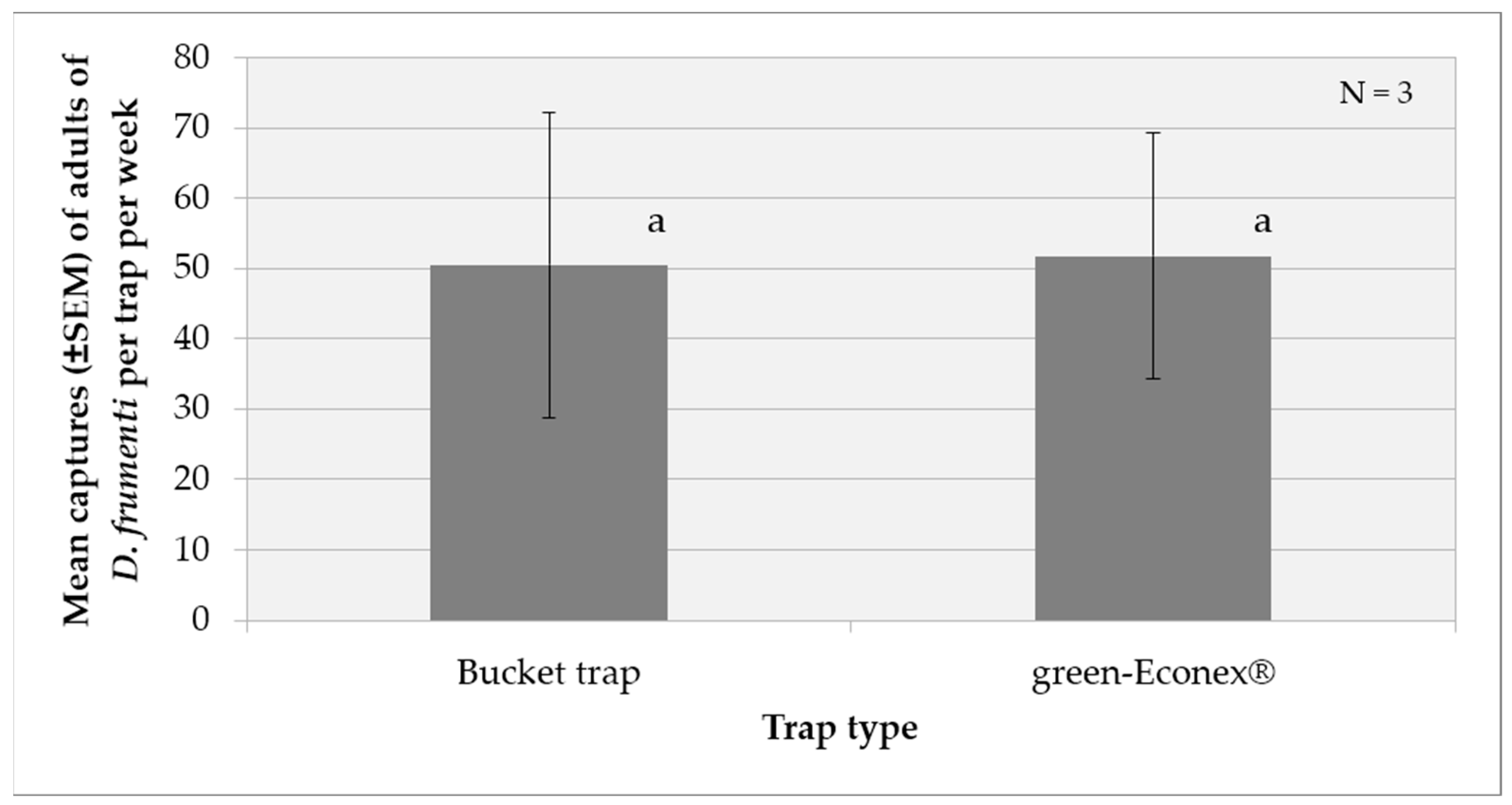
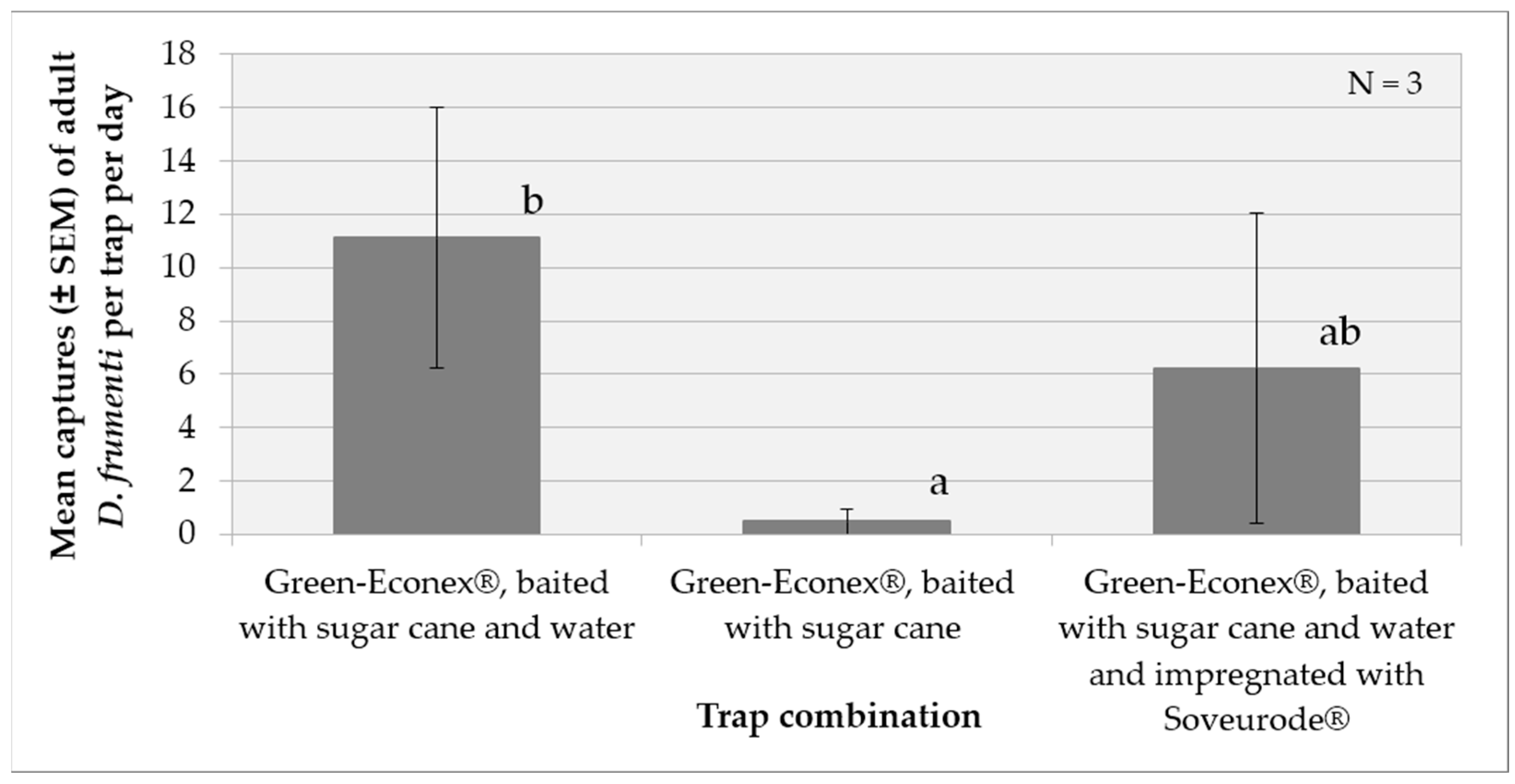
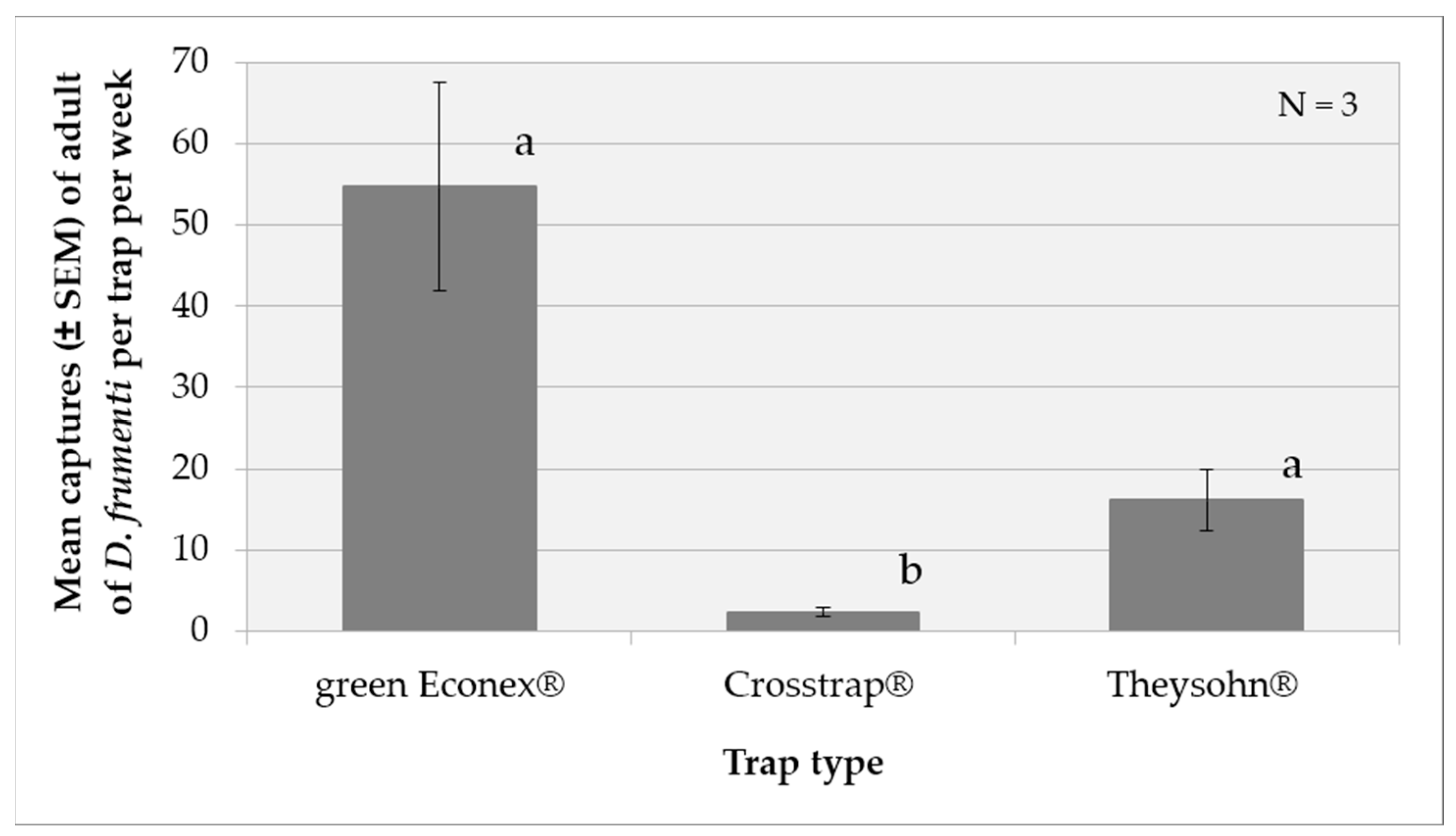
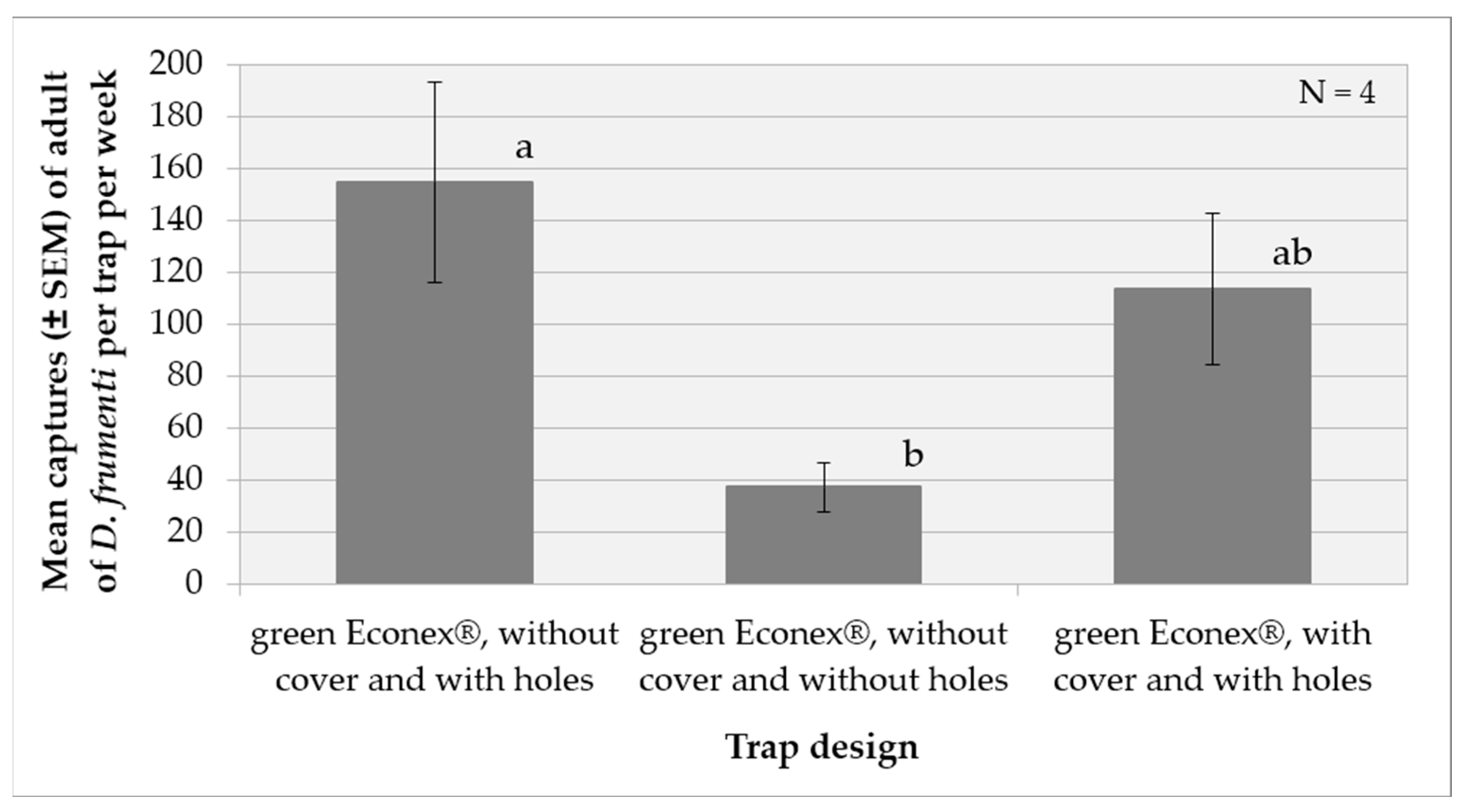
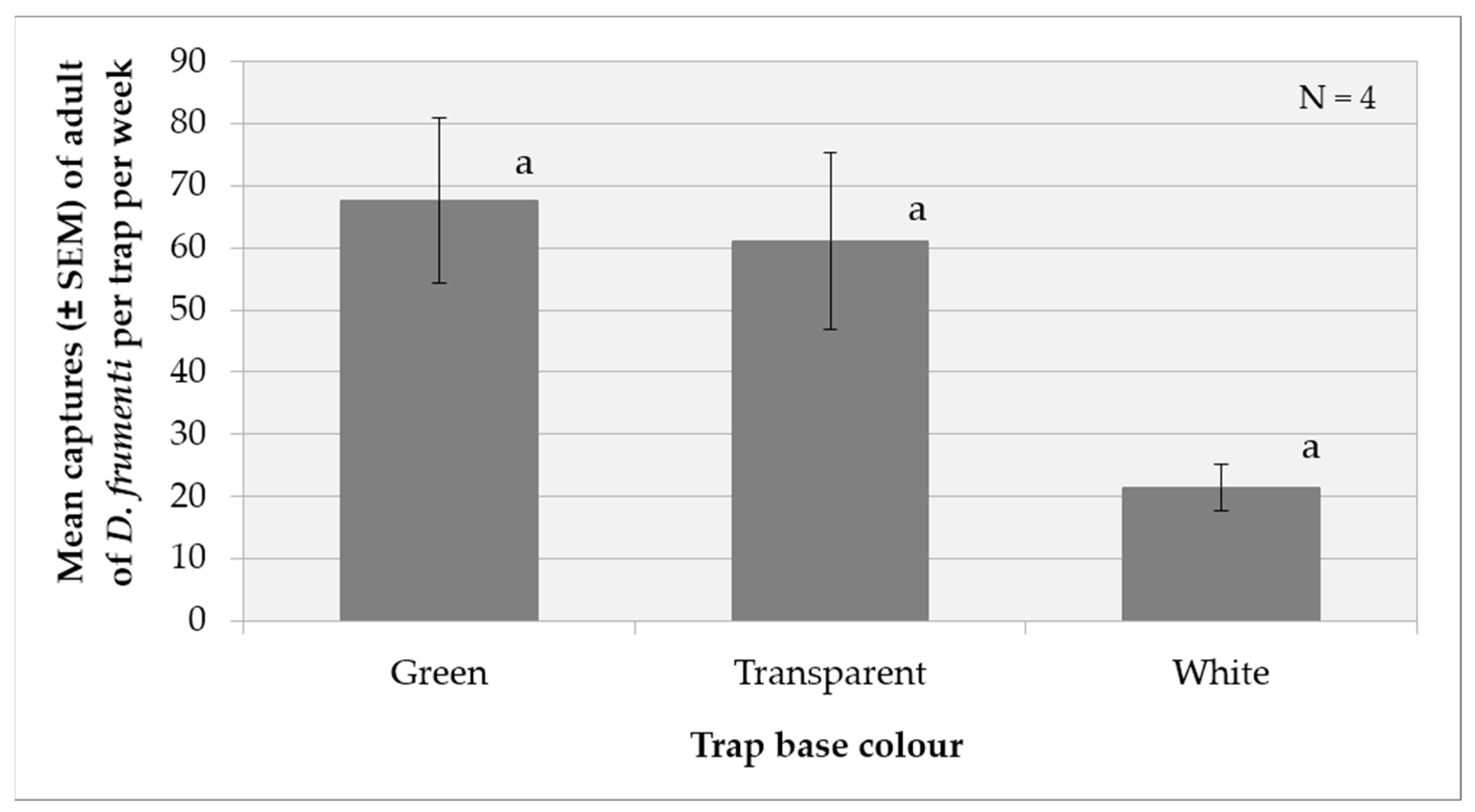
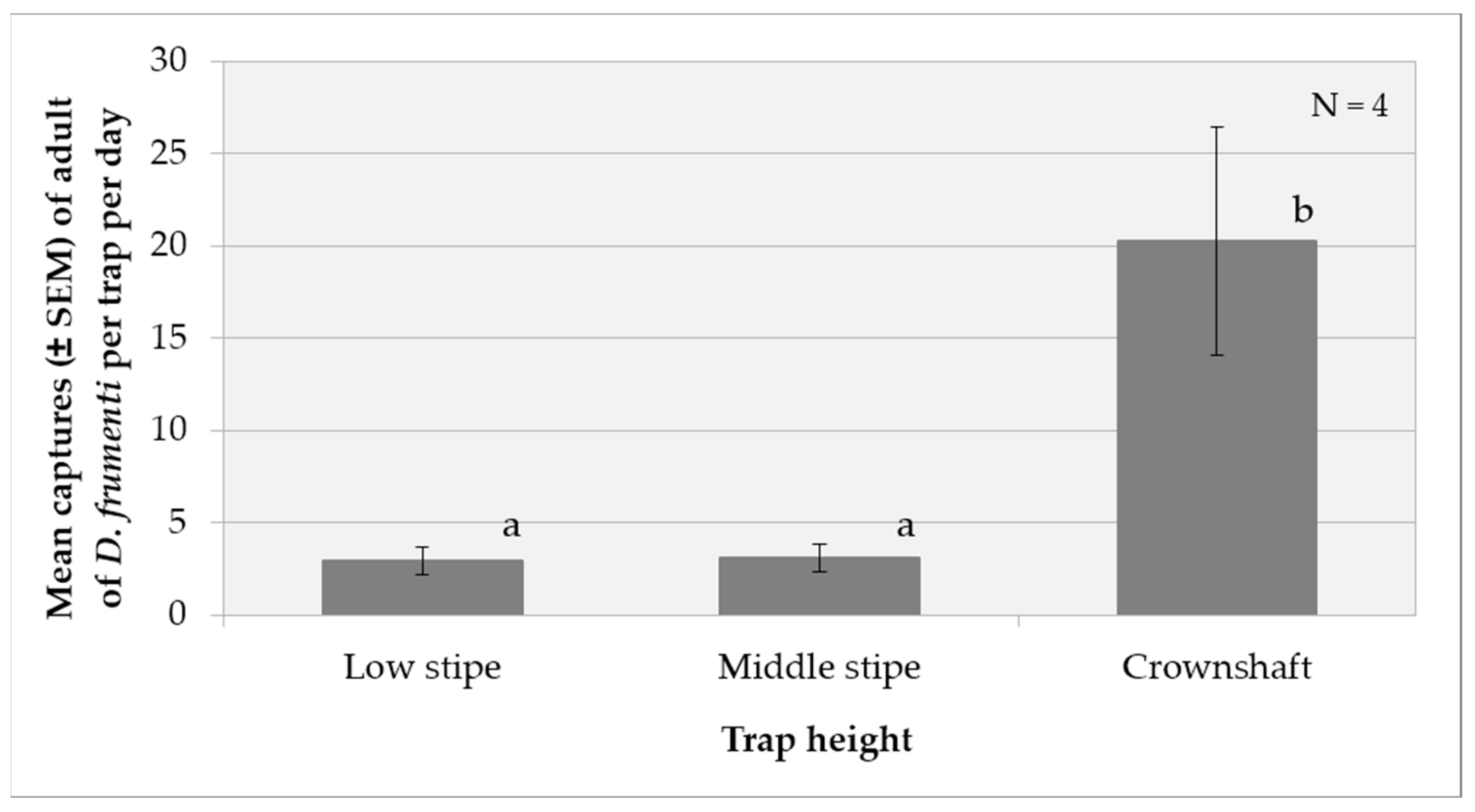

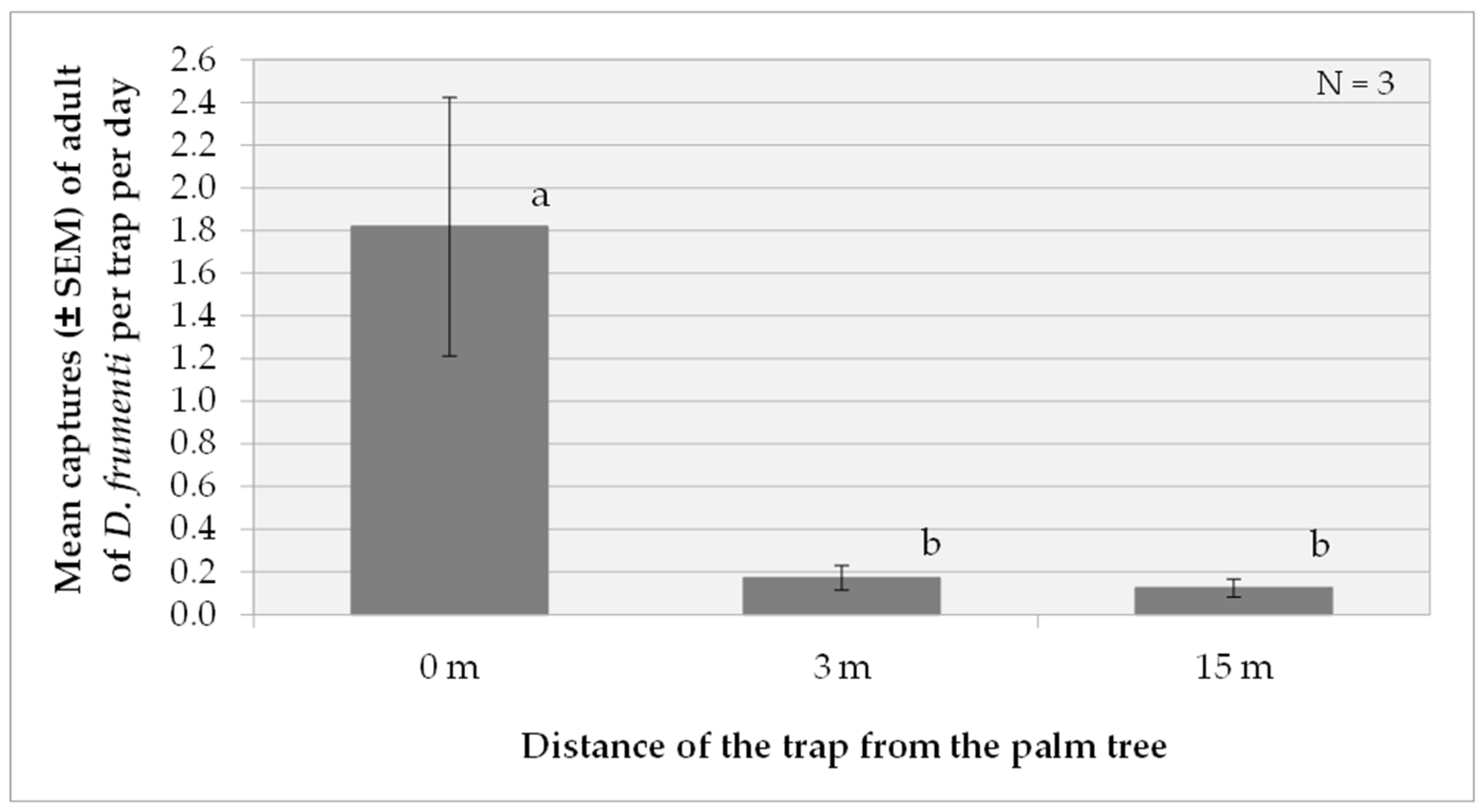
| Initial Test | Test Area and Test Period | Treatments Tested | |
|---|---|---|---|
| 1. Evaluation of different traps in the capture of D. frumenti | Apartamentos Eureka (Arona, Tenerife) 28°00′25″ N 16°38′39″ W 23 m a.s.l. Landscaped area of 1.29 ha. Trial period: 5 weeks (5 June–25 July 2014) N° of simultaneous repetitions: 3. | Traps: (a) Bucket type, 15-L capacity, black in color, with ventilation holes in the base and lid, baited with 1 kg of sugar cane and water, and hung from the first green leaf ring of the palm’s crownshaft; (b) green Econex®, without a cover and with ventilation holes, baited with 200 g of sugar cane and water, and placed inserted between the first and second green leaf rings of the palm’s crownshaft. |  |
| 2. Evaluation of the need to add water to the trap in the capture of D. frumenti | Parque Romano (Las Palmas de Gran Canaria, Gran Canaria) 28°07′29″ N 15°25′38″ W 5 m a.s.l. Urban park of 1.45 ha Trial period: 2 weeks (29 July–14 August 2013) N° of simultaneous repetitions: 3. | Green Econex® trap baited with (a) sugar cane and water; (b) sugar cane; (c) sugar cane, water and impregnated internally with Soveurode®. |  |
| Trial | Trial Area, Trial Period and n° of Repetitions | Treatments Tested | ||
|---|---|---|---|---|
| Trap design | 1. Effect of trap type on D. frumenti captures | Parque Don Benito (Gran Canaria) 28°06′45″ N 15°25′47″ W 101 m a.s.l. Urban park of 5045 m2 Test period: 6 weeks (18 June–30 July 2015) N° of simultaneous repetitions: 3. | Traps: (a) green Econex®; (b) Crosstrap®; (c) Theysohn®. | 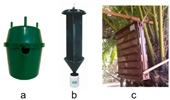 |
| 2. Effect of trap design on D. frumenti captures | Campo Internacional (Gran Canaria) 27°45′39″ N 15°25′16″ W 30 m a.s.l. Urban palm grove of 8503 m2. Trial period: 4 weeks (3 November–1 December 2014) N° of simultaneous repetitions: 4 | Econex® trap (a) without top cover and with ventilation holes; (b) without cover and ventilation holes; (c) with cover and ventilation holes. |  | |
| 3. Effect of trap base colour on D. frumenti captures | Campo Internacional (Gran Canaria) 27°45′39″ N 15°25′16″ W 30 m a.s.l. Urban palm grove of 8503 m2. Trial period: 4 weeks (3 November–1 December 2014) N° of simultaneous repetitions: 4 | Econex® trap, with base colour (a) green; (b) transparent; (c) white. |  | |
| Location of the trap | 4. Effect of trap height on D. frumenti captures | Avenida Tour Operador Tui (Gran Canaria) 27°45′39″ N 15°35′16″ W 30 m a.s.l. 583 m palm alignment Test period: 3 weeks (27 October–18 November 2016) N° of simultaneous repetitions: 4 | Green Econex® trap, placed (a) in the stipe, 40 cm above the ground; (b) in the stipe, at mid-height; (c) in the crownshaft, between the first and second ring of green leaves; | 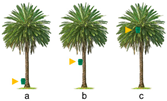 |
| 5. Effect of trap placement distance from the palm tree on D. frumenti captures. | Parque Tony Gallardo (Gran Canaria) 27°44′47″ N 15°35′55″ W 7 m a.s.l. Botanical Garden of 8.93 ha Trial period: 3 weeks (27 October–18 November 2016) N° of simultaneous repetitions: 4 | Green Econex® trap, placed on a pole 1.20 m above the ground at (a) 0 m; (b) 3 m; (c) 15 m, with respect to the palm tree. | 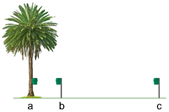 | |
| Vidrieras Canarias S.A. (Gran Canaria) 27°58′47″ N 15°23′12″ W 39 m a.s.l. Plot of 6.46 ha Trial period: 3 weeks (11–31 October 2016) N° of simultaneous repetitions: 4 | ||||
| 6. Effect of trap location on catches of D. frumenti | Vidrieras Canarias S.A. (Gran Canaria) 27°58′47″ N 15°23′12″ W 39 m a.s.l. Plot of 6.46 ha Trial period: 3 weeks (7–28 March 2017) N° of simultaneous repetitions: 3 | Green Econex® trap, placed (a) at 0 m, on the crownshaft; (b) at 5 m, on a post at crownshaft height; (c) at 5 m, on a post 40 cm above the ground. | 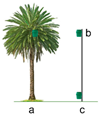 |
| Test/Trial | Male | Female | Sex Ratio | Levene’s Test | Student’s t-Test | |||||
|---|---|---|---|---|---|---|---|---|---|---|
| N° | % | N° | % | ♂:♀ | F | p | t | d.f. | p | |
| Test | ||||||||||
| 1 | 676 | 47.11 | 759 | 52.89 | 1:1.12 | 0.101 | 0.752 | −0.320 | 48 | 0.750 |
| 2 | 488 | 50.31 | 482 | 49.69 | 1:0.99 | 0.010 | 0.923 | 0.014 | 34 | 0.989 |
| Trials | ||||||||||
| 1 | 609 | 46.28 | 707 | 53.72 | 1:1.16 | 0.168 | 0.683 | −0.304 | 106 | 0.762 |
| 2 | 2318 | 48.56 | 2455 | 51.44 | 1:1.06 | 0.138 | 0.711 | −0.171 | 92 | 0.865 |
| 3 | 2249 | 48.65 | 2374 | 51.35 | 1:1.06 | 0.335 | 0.564 | −0.194 | 90 | 0.847 |
| 4 | 1040 | 43.86 | 1331 | 56.14 | 1:1.28 | 0.579 | 0.449 | −0.596 | 70 | 0.553 |
| 5 (I) | 63 | 43.75 | 81 | 56.25 | 1:1.29 | 0.487 | 0.488 | −0.585 | 70 | 0.560 |
| 5 (II) | 49 | 38.89 | 77 | 61.11 | 1:1.57 | 7.891 | 0.007 * | −1.211 | 52 | 0.231 |
| 6 | 76 | 43.93 | 97 | 56.07 | 1:1.28 | 0.444 | 0.508 | −0.350 | 52 | 0.728 |
Disclaimer/Publisher’s Note: The statements, opinions and data contained in all publications are solely those of the individual author(s) and contributor(s) and not of MDPI and/or the editor(s). MDPI and/or the editor(s) disclaim responsibility for any injury to people or property resulting from any ideas, methods, instructions or products referred to in the content. |
© 2024 by the authors. Licensee MDPI, Basel, Switzerland. This article is an open access article distributed under the terms and conditions of the Creative Commons Attribution (CC BY) license (https://creativecommons.org/licenses/by/4.0/).
Share and Cite
Ramos-Cordero, C.; Seris-Barrallo, E.; Vacas, S.; Navarro-Llopis, V.; Hernández-Suárez, E.M. Effect of Commercial Trap Design and Location on Captures of Diocalandra frumenti (Fabricius) (Coleoptera: Dryophthoridae) on Palm Trees. Insects 2024, 15, 738. https://doi.org/10.3390/insects15100738
Ramos-Cordero C, Seris-Barrallo E, Vacas S, Navarro-Llopis V, Hernández-Suárez EM. Effect of Commercial Trap Design and Location on Captures of Diocalandra frumenti (Fabricius) (Coleoptera: Dryophthoridae) on Palm Trees. Insects. 2024; 15(10):738. https://doi.org/10.3390/insects15100738
Chicago/Turabian StyleRamos-Cordero, Carina, Elena Seris-Barrallo, Sandra Vacas, Vicente Navarro-Llopis, and Estrella M. Hernández-Suárez. 2024. "Effect of Commercial Trap Design and Location on Captures of Diocalandra frumenti (Fabricius) (Coleoptera: Dryophthoridae) on Palm Trees" Insects 15, no. 10: 738. https://doi.org/10.3390/insects15100738
APA StyleRamos-Cordero, C., Seris-Barrallo, E., Vacas, S., Navarro-Llopis, V., & Hernández-Suárez, E. M. (2024). Effect of Commercial Trap Design and Location on Captures of Diocalandra frumenti (Fabricius) (Coleoptera: Dryophthoridae) on Palm Trees. Insects, 15(10), 738. https://doi.org/10.3390/insects15100738









